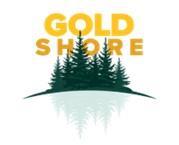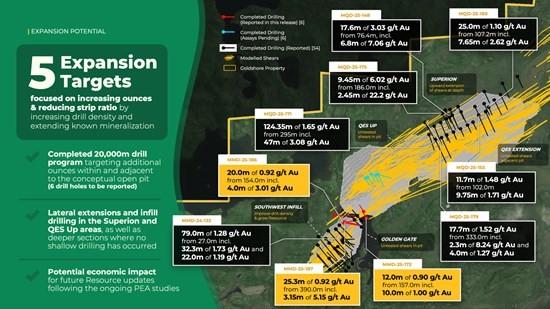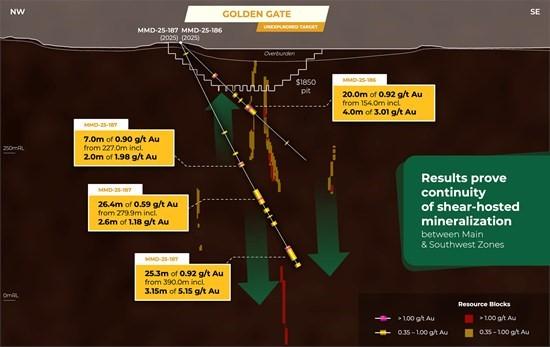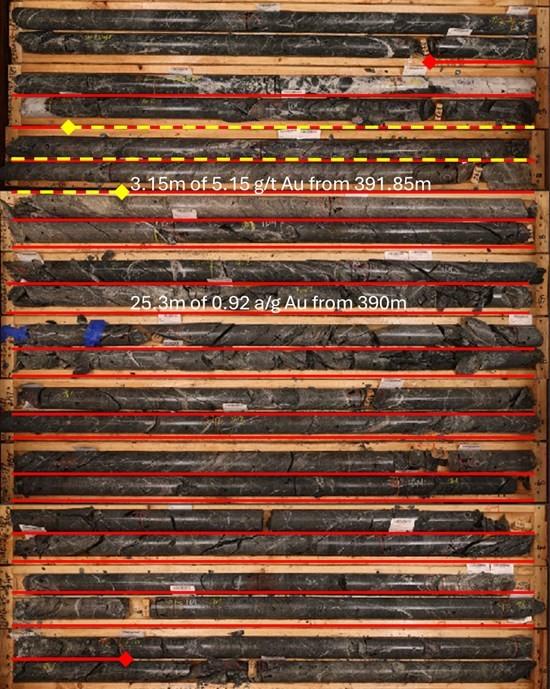
Goldshore Intersects 25.3m of 0.92 g/t Au, Including 3.15m of 5.15 g/t Au from 391.85m, Proving Continuity of Shears Between the Main and Southwest Zones

Goldshore Resources Inc. (TSX-V: GSHR) (OTCQB: GSHRF) (FSE: 8X00) is pleased to announce its latest assay results from its recently completed 20,000-meter winter drill program with the final results from the Golden Gate Zone, a previously undrilled section between the Main and Southwest Zones of the Moss Gold Project in Northwest Ontario, Canada. A total of 1,380 meters were drilled underneath a saddle in the conceptual open pit with the goal of expanding the resource beneath the current proposed open pit for a future mineral resource estimate.
Michael Henrichsen, CEO of Goldshore, commented, “We are pleased to drill mineralization within the Golden Gate Zone, the gap between the Southwest and Main zones. The recent drilling has occurred in a volume that is currently modelled as having few shears extending from the neighbouring zones and as a result the numerous shears intersected will convert waste in the current resource mode to mineralized resource. This should enable the Southwest and Main Zone conceptual open pits to join into a single proposed pit with a less pronounced saddle.”
Highlights
- Four drill holes were completed to infill a data gap beneath a saddle in the conceptual open pit between the Main and Southwest Zones, an area that was previously untested and had mineralized shears extended from the neighboring areas. Drilling intersected medium-grade marginal shears that confirm the continuity of mineralized shears through this volume with best intercepts of:
- 2.75m of 3.08 g/t Au from 119.25m in MMD-25-184
- 20m of 0.92 g/t Au from 154m in MMD-25-186, including
- 4m of 3.01 g/t Au from 159m
- 26.35m of 0.59 g/t Au from 279.85m in MMD-25-187, and
- 25.3m of 0.92 g/t Au from 390m, including
- 3.15m of 5.15 g/t Au from 391.85m
- Results from the two remaining shallow holes drilled from ice last winter tested shallow parts of marginal shears on the southern flank of the Main Zone confirming the extension of marginal shears including:
- 12m of 0.90 g/t Au from 157m in MMD-25-172, including
- 10m of 1.00 g/t Au from 157m
- 8.2m of 0.88 g/t Au from 90.8m in MMD-25-173, including
- 2.2m of 2.84 g/t Au from 157m
- 12m of 0.90 g/t Au from 157m in MMD-25-172, including
Technical Overview
Figure 1 shows the location of the drill holes being reported with respect to the completed winter drill program, while Figure 2 illustrates a cross section through drill holes MMD-25-186 and MMD-25-187 that demonstrates the potential to extend the mineralized shears zones between the Main and Southwest Zones to depth. Tables 1 & 2 summarize significant intercepts and drill hole locations, respectively.

Figure 1: Illustrates the 2025 completed winter drill program targeting resource expansion within the conceptual open pit outlined in grey. Drill holes being reported are highlighted in red.

Figure 2: Drill section through holes MMD-25-186 and -187 illustrating the discovery of a new set of medium-grade gold-mineralized shears that connects the Main and Southwest Zones
Hole MMD-25-172 was drilled from Snodgrass Lake during the winter ice drilling program testing the shallow extension of deeper marginal shears on the southern flank of the Main Zone. The hole collared into an alternating andesite and dacitic volcanic package with swarms of meter-scale weak to moderately sheared, sericite-silica-chlorite altered diorite and porphyritic diorite. Stronger sheared sections of diorite were mineralized with the presence of pyrite and chalcopyrite returning a modest intercept of 12m of 0.90 g/t Au from 157m, including 10m of 1.00 g/t Au from 157m up dip and along strike of existing mineralized marginal shears.
Hole MMD-25-173 was drilled from Snodgrass Lake, approximately100m north of MMD-25-172. The hole collared into alternating dacitic and andesitic volcanics before intersecting the Main Zone sericite-hematite and epidote-chlorite altered diorite complex at 90m. Local areas of more intense shearing contained higher-grade mineralization of pyrite and chalcopyrite with intercepts of 8.2m of 0.88 g/t Au from 90.8m, including 2.2m of 2.84 g/t Au from 90.8m, and 14.0m of 0.35 g/t Au from 160m. The hole was stopped short of the core shear network as the volume had been previously drilled.
Holes MMD-25-184, MMD-25-186, and MMD-25-187 were drilled from the same setup on the western shore of Snodgrass Lake, targeting the gap between the Main and Southwest Zones to test the continuity of mineralized shears between the two zones. The holes were drilled at an oblique angle to the primary foliation due to restricted drill sites. This provided the added benefit of testing a possible NS-structure that offsets the Southwest Zone from the main Moss structure corridor.
All holes collared in a porphyritic diorite and quickly transitioned into dacite volcanics with swarms of weak to moderately sheared, sericite-silica-hematite altered diorite and granodiorite dykes increasing in frequency and alteration and mineralization intensity with depth. At approximately 100m the hole intersected roughly one hundred meters of sheared, sericite-silica-hematite altered diorite package with pyrite mineralization returning intercepts including 8.3m of 0.63 g/t Au from 105.7m and 2.75m of 3.08 g/t Au from 119.25m in MMD-25-184; 20m of 0.92 g/t Au from 154m, including 4m of 3.01 g/t Au from 159m in MMD-25-186; and 26.35m of 0.59 g/t Au from 279.85m in MMD-25-187. The overall lithological and alteration package appear more similar to the Southwest Zone than the Main Zone with the location of the intercepts suggesting the two zones are not directly connected. Holes MMD-25-184 and -186, which were drilled at the same declination but 20° different azimuths, intersected a wide volcanic section characterized by strong late brecciation and local faulting after which the frequency of diorite intrusions are greatly reduced. MMD-25-187, which was drilled more steeply beneath MMD-25-186, intersected the zone of late brittle deformation notably deeper than the up-dip holes after intersecting a second one hundred and fifty meter wide sericite-chlorite altered diorite complex, returning an intercept of 25.3m of 0.92 g/t Au from 390m, including 3.15m of 5.15 g/t Au from 391.85m, suggesting a modest western dip to the structure.
Hole MMD-25-195 was drilled 135m northwest along the shore of Snodgrass Lake at a similar oblique angle. The hole collared into a dacite volcanic dominated sequence with swarms of weakly sheared, sericite-silica-hematite altered diorite, porphyritic diorite, and granodiorite dykes. The dykes are weakly mineralized with pyrite and narrow low-grade intercepts, such as 5.55m of 0.52 g/t Au from 213.45 and 6.45m of 0.51 g/t Au from 328m. The hole intersected a similar a wide volcanic section with strong late brecciation and local faulting after which the diorite intrusions become notably less frequent.

Figure 3: Hole MMD-25-187: Brecciated and faulted contact of sheared altered diorite and intermediate volcanics with intercept of 25.3m of 0.92 g/t Au from 390m, including 3.15m of 5.15 g/t Au from 391.85m.
Table 1: Significant intercepts
| HOLE ID | FROM | TO | LENGTH (m) |
TRUE WIDTH (m) |
CUT GRADE (g/t Au) |
UNCUT GRADE (g/t Au) |
| MMD-25-172 | 19.00 | 21.00 | 2.00 | 0.8 | 0.43 | 0.43 |
| 143.00 | 147.00 | 4.00 | 1.8 | 0.51 | 0.51 | |
| 157.00 | 169.00 | 12.00 | 5.6 | 0.90 | 0.90 | |
| incl | 157.00 | 167.00 | 10.00 | 4.6 | 1.00 | 1.00 |
| 198.00 | 200.80 | 2.80 | 1.3 | 0.42 | 0.42 | |
| MMD-25-173 | 90.80 | 99.00 | 8.20 | 4.2 | 0.88 | 0.88 |
| incl | 90.80 | 93.00 | 2.20 | 1.1 | 2.84 | 2.84 |
| 124.00 | 130.00 | 6.00 | 3.2 | 0.57 | 0.57 | |
| 160.00 | 174.00 | 14.00 | 7.6 | 0.35 | 0.35 | |
| 191.00 | 197.00 | 6.00 | 3.3 | 0.57 | 0.57 | |
| 203.00 | 206.00 | 3.00 | 1.7 | 0.53 | 0.53 | |
| MMD-25-184 | 105.70 | 114.00 | 8.30 | 3.0 | 0.63 | 0.63 |
| 119.25 | 122.00 | 2.75 | 1.0 | 3.08 | 3.08 | |
| 166.00 | 170.00 | 4.00 | 1.5 | 1.00 | 1.00 | |
| 176.50 | 180.90 | 4.40 | 1.6 | 0.70 | 0.70 | |
| 189.00 | 198.95 | 9.95 | 3.7 | 0.53 | 0.53 | |
| MMD-25-186 | 77.35 | 83.00 | 5.65 | 4.1 | 0.50 | 0.50 |
| incl | 81.00 | 83.00 | 2.00 | 1.4 | 1.03 | 1.03 |
| 125.00 | 130.50 | 5.50 | 4.0 | 0.38 | 0.38 | |
| 139.00 | 142.00 | 3.00 | 2.2 | 0.46 | 0.46 | |
| 154.00 | 174.00 | 20.00 | 14.6 | 0.92 | 0.92 | |
| incl | 159.00 | 163.00 | 4.00 | 2.9 | 3.01 | 3.01 |
| 246.00 | 248.00 | 2.00 | 1.5 | 0.35 | 0.35 | |
| MMD-25-187 | 20.00 | 22.00 | 2.00 | 0.8 | 0.42 | 0.42 |
| 168.00 | 171.00 | 3.00 | 1.4 | 0.75 | 0.75 | |
| 208.00 | 211.40 | 3.40 | 1.6 | 0.42 | 0.42 | |
| 227.00 | 234.00 | 7.00 | 3.3 | 0.90 | 0.90 | |
| incl | 229.00 | 231.00 | 2.00 | 0.9 | 1.98 | 1.98 |
| 279.85 | 306.20 | 26.35 | 12.8 | 0.59 | 0.59 | |
| incl | 296.00 | 298.55 | 2.55 | 1.2 | 1.18 | 1.18 |
| 316.00 | 322.30 | 6.30 | 3.1 | 0.43 | 0.43 | |
| 329.90 | 332.00 | 2.10 | 1.0 | 0.95 | 0.95 | |
| 342.00 | 348.00 | 6.00 | 3.0 | 0.63 | 0.63 | |
| 390.00 | 415.30 | 25.30 | 12.7 | 0.92 | 0.92 | |
| incl | 391.85 | 395.00 | 3.15 | 1.6 | 5.15 | 5.15 |
| 423.00 | 429.00 | 6.00 | 3.0 | 0.38 | 0.38 | |
| MMD-25-195 | 213.45 | 219.00 | 5.55 | 2.2 | 0.52 | 0.52 |
| 302.40 | 314.90 | 12.50 | 5.2 | 0.31 | 0.31 | |
| 328.00 | 334.45 | 6.45 | 2.7 | 0.51 | 0.51 | |
| 392.00 | 399.00 | 7.00 | 2.9 | 0.31 | 0.31 | |
| Intersections calculated above a 0.3 g/t Au cut off with a top cut of 30 g/t Au and a maximum internal waste interval of 5 metres. Shaded intervals are intersections calculated above a 1.0 g/t Au cut off. Intervals in bold are those with a grade thickness factor exceeding 20 gram x metres / tonne gold. True widths are approximate and assume a subvertical body. | ||||||
Table 2: Drill Collars
| HOLE | EAST | NORTH | RL | AZIMUTH | DIP | EOH |
| MMD-25-172 | 668,831 | 5,378,606 | 426 | 328.0 | -66.5 | 252.00 |
| MMD-25-173 | 668,795 | 5,378,690 | 426 | 328.1 | -66.9 | 252.00 |
| MMD-25-184 | 668,537 | 5,378,547 | 437 | 80.2 | -44.8 | 249.00 |
| MMD-25-186 | 668,537 | 5,378,546 | 437 | 100.6 | -44.9 | 291.00 |
| MMD-25-187 | 668,537 | 5,378,546 | 437 | 100.7 | -65.0 | 429.00 |
| MMD-25-195 | 668,412 | 5,378,643 | 428 | 92.1 | -44.9 | 411.10 |
Analytical and QA/QC Procedures
The HQ diameter drill core (NQ-diameter for holes MMD-25-172 and -173) has been oriented using ACTIII or equivalent tools and validated in the core shack. All core has been sawed in half cut just off the core orientation line (bottom of hole) with the right half (looking down hole) of the core bagged and sent a third-party analytical laboratory. The left half of the core was returned to core boxes and is stored at Goldshore’s Kashabowie core yard facility.
All samples were sent to ALS Geochemistry in Thunder Bay for preparation and analysis was performed in the ALS Vancouver analytical facility. ALS is accredited by the Standards Council of Canada (SCC) for the Accreditation of Mineral Analysis Testing Laboratories and CAN-P-4E ISO/IEC 17025. Samples were analysed for gold via fire assay with an AA finish (“Au-AA23“) and 48 pathfinder elements via ICP-MS after four-acid digestion (“ME-MS61“). Samples that assayed over 10 ppm Au were re-run via fire assay with a gravimetric finish (“Au-GRA21“).
In addition to ALS quality assurance / quality control protocols, Goldshore has implemented a quality control program for all samples collected through the drilling program. The quality control program was designed by a qualified and independent third party, with a focus on the quality of analytical results for gold. Analytical results are received, imported to our secure on-line database and evaluated to meet our established guidelines to ensure that all sample batches pass industry best practice for analytical quality control. Certified reference materials are considered acceptable if values returned are within three standard deviations of the certified value reported by the manufacture of the material. In addition to the certified reference material, certified blank material is included in the sample stream to monitor contamination during sample preparation. Blank material results are assessed based on the returned gold result being less than ten times the quoted lower detection limit of the analytical method. The results of the on-going analytical quality control program are evaluated and reported to Goldshore by Orix Geoscience Inc.
Qualified Person
Peter Flindell, PGeo, MAusIMM, MAIG, Vice-President, Exploration, of the Company, and a qualified person under National Instrument 43-101 – Standards of Disclosure for Mineral Projects, has approved the scientific and technical information contained in this news release.
Mr. Flindell has verified the data disclosed. To verify the information related to the winter drill program at the Moss Gold Project, Mr. Flindell has visited the property several times; discussed and reviewed logging, sampling, bulk density, core cutting and sample shipping processes with responsible site staff; discussed and reviewed assay and QA/QC results with responsible personnel; and reviewed supporting documentation, including drill hole location and orientation and significant assay interval calculations. He has also overseen the Company’s health and safety policies in the field to ensure full compliance, and consulted with the Project’s host indigenous communities on the planning and implementation of the drill program, particularly with respect to its impact on the environment and the Company’s remediation protocols.
Amendment to NPI Agreement
The Company also announces that it has entered into an amending agreement to the net profit interest purchase agreement dated May 1, 2025, previously disclosed in the Company’s news release dated May 30, 2025. Pursuant to the amendment, the Company has set a limit on the number of shares issuable to the NPI vendor as part of the final consideration payable under the Agreement. Specifically, the total number of shares issuable on the fourth anniversary of the NPI Agreement will not exceed 1,176,470 common shares. All other terms and conditions of the Agreement remain unchanged.
About Goldshore
Goldshore is a growth-oriented gold company focused on delivering long-term shareholder and stakeholder value through the acquisition and advancement of primary gold assets in tier-one jurisdictions. It is led by the ex-global head of structural geology for the world’s largest gold company and backed by one of Canada’s pre-eminent private equity firms. The Company’s current focus is the advanced stage 100% owned Moss Gold Project which is positioned in Ontario, Canada, with direct access from the Trans-Canada Highway, hydroelectric power near site, supportive local communities and skilled workforce. The Company has invested over $75 million of new capital and completed approximately 100,000 meters of drilling on the Moss Gold Project, which, in aggregate, has had over 255,000 meters of drilling. The 2024 updated NI 43-101 mineral resource estimate has expanded to 1.54 million ounces of Indicated gold resources at 1.23 g/t Au and 5.20 million ounces of Inferred gold resources at 1.11 g/t Au. The MRE only encompasses 3.6 kilometers of the 35+ kilometer mineralized trend, remains open at depth and along strike and is one of the few remaining major Canadian gold deposits positioned for development in this cycle. Please see NI 43-101 technical report titled: “Technical Report and Updated Mineral Resource Estimate for the Moss Gold Project, Ontario, Canada,” dated March 20, 2024 with an effective date of January 31, 2024 available under the Company’s SEDAR+ profile at www.sedarplus.ca.
MORE or "UNCATEGORIZED"
Azimut agrees to sell its interest in the Galinée Property to LiFT Power, James Bay Region, Quebec
Azimut Exploration Inc. (TSX-V: AZM) (OTCQX: AZMTF) announces the... READ MORE
Sun Summit Announces Closing of $11.5 Million Non-Brokered Private Placement
Sun Summit Minerals Corp. (TSX-V: SMN) (OTCQB: SMREF) is pleased ... READ MORE
Under the Spotlight – Bruce Counts, CEO Storm Exploration
Rick Mills, Editor/ Publisher, Ahead of the Herd: Bruce, why do... READ MORE
Apollo Silver Announces $25 Million Strategic Investment by Eric Sprott and Jupiter Asset Management
Apollo Silver Corp. (TSX-V:APGO) (OTCQB:APGOF) (Frankfurt:6ZF0) ... READ MORE
StrikePoint Gold Plans for a Successful 2026
StrikePoint Gold Inc. (TSX-V:SKP) (OTCQB:STKXF) is pleased to p... READ MORE












